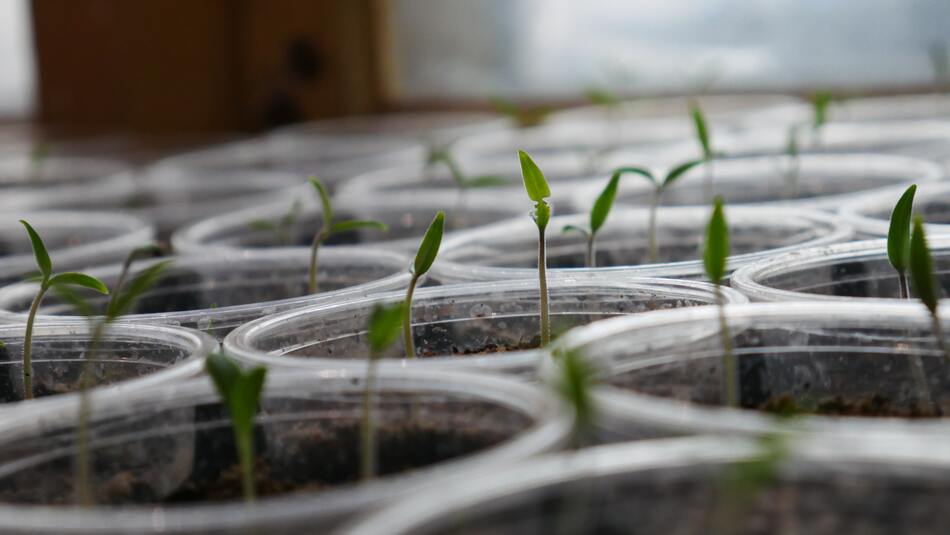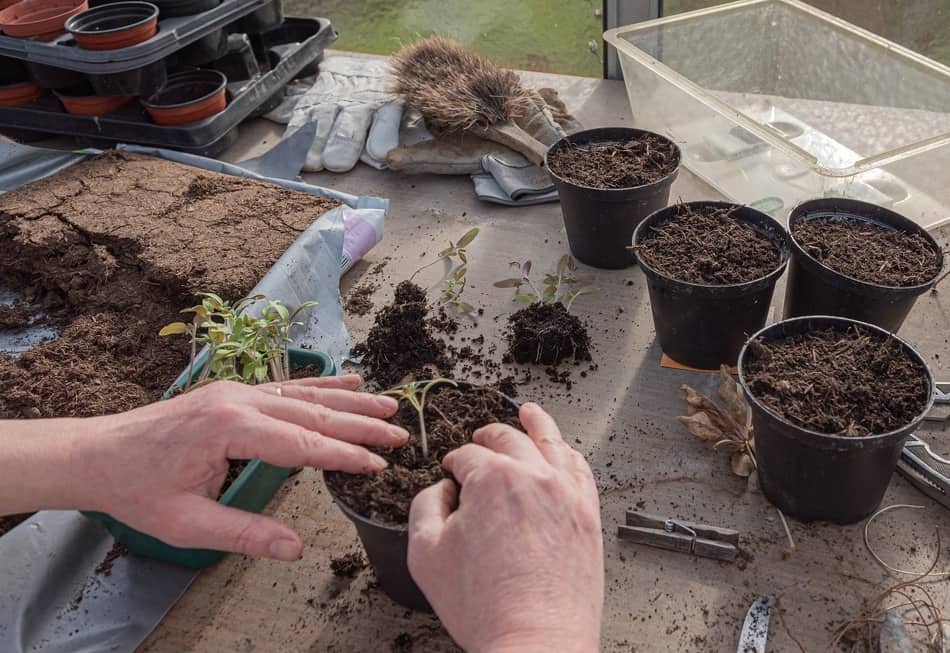In this blog post, you will learn the step-by-step guide to How to Grow Tomatoes Indoors. The principles are the same as growing outside since the plant needs the same factors to grow healthy. Nevertheless, it’s important to take note of some specific points when considering planting indoors.
The planting process has 5 main steps. The variety selection, soil preparation with the correct starter solid. The light and temperatures are also critical factors since we are growing inside, a good bright window is ideal. Lastly, a good watering schedule is a must to guarantee good development.
Having this 5-point narrowed-down task is easy peasy, however, having a piece of good knowledge about every step is important to take your growing skills to the next level.
Part 1 – Materials – How to grow tomatoes indoors
Variety Selection
The first important factor to consider is the variety of tomatoes we are planting. Determine tomatoes are great for indoors since they don’t grow as much as the indeterminate, however, the indeterminate could produce fruits all year long. But planting more than one seed (determine) with a space of 10/15 days can guarantee a constant supply of tomatoes.
The varieties of tomatoes are plenty, from the color to the shape of the final fruit, it all depends on your choice, but here are some examples of the varieties available.
Red Robin: This plant is small and perfect for pods. Produces small to medium sizes tomatoes. If the fruits get heavy a cage might be needed.
Tiny Tim: This variety produces small-size tomatoes, cherry type. Very small plant. Perfect to place over a desk near a window.
Roma: fruit medium, produces a very juicy fruit good to make sauces. Plant medium size to large need to be in a pot on the floor, not good to be over a desk. If the fruits get heavy support is recommended to hold the plant and fruit. Matures in 70-80 days. Grows between 4-6 ft tall.
Patio: is a hybrid excellent small space, produces a medium to big size fruit. Must have support to hold the fruits. usually matures in 70 days. Grows about 2-2.2 ft tall.
Bush Tomatoes: This plant is compact but produces very good size fruits. Will grow about 3-5 ft and will mature in about 65/68 days.
Soil
Germination: The tomatoes like soils with rich organic material but loose, the ph must be neutral to acidic. For the germination stage, we could use all-purpose germination soil, no need to get too techy here, try to find some near the recommendation.
Development: for the development stage is more critical to find soil recommended as close as possible to the ideal since the plant will spend 50/55 days in the same container. If you get soil with too much organic material we could have a draining problem. Look for rich in organic matter but lose structure.
Seedling Trays
This item is not as important as the previous two. But selecting a good tray could help you with the handling. We recommend biodegradable trays since they can be broken into sections and planted directly. But plastic trays are also good.
Containers – Pots
Since this will be the final placing of the plant is nice to look for medium to large containers depending on the variety chosen. Consider good drainage holes in the bottom, which is important to prevent excess water. Remember, tomatoes prefer loose soil.

Part 2 – Step by Step – How to grow tomatoes indoors
Sowing & Germination
Sowing
Add your soil to the seedling trays and water them until most, don’t overdo it, we want moist soil, not wet soil. After this poke 1 hole for every space, the hole must be about 1/4 inch deep. With your hands or with tweezers place 2/3 seed for every hole. Why 2 or 3 seeds? Because in some cases the germination could be low, and in case 1 fails you have 2 more seeds for backup, later if we have more than 1 plant emerging, we could eliminate the other two. After this is done gently cover the seed with more soil and moist gently. Depending on the variety expect to eat your tomatoes 90/100 days later.
Germination
Germination is the process by which a seed becomes a seedling. This process will occur around the 5th o 10th day depending on the conditions, give it an extra 2/3 days if you don’t see progress, being patient is not an exact number of days. on the other hand if after 20/25 days you don’t see progress, is probably not going to emerge.
For ideal germination, the tomato seeds need to be watered constantly with a gentle moist, try to use fine drops in other avoid moving the seed inside the tray, and water every day gently. The temperature should be around 70/80 F.
After emerging the first leaves, be sure to have the tray near the source of light. The plants need at least 8 hours per day, continue watering with gentle drops every day until the soil is moist, ideally in the mornings.
Pro Tip: to speed up the germination process, use a closed germination tray in other to keep the soil moist, if you don’t have a closed tray you can use paper film above the plastic or paper tray, however, you will still need to water the soil 3/4 times a week.
Transplanting
After the germination happens we want to give the plants some time to grow healthy roots and leaves before moving them to the ultimate. Some recommend having 2 transplants, one in an intermediate pot and later in the last developing pot. Our suggestion is only to do 1 transplant since we don’t want to generate stress on our little tomatoes. Consider that every time to take the plant out of one pot to another pot you generate stress and this might impact the overall health of the plant.
The time to transplant the tomatoes is when the plant grows two sets of leaves. Prepare the soil in the final container or pot by watering gently, making a hole wide as the container tray, and placing the plant as center as possible, after that press down and cover with more soil finally water another time gently. Remember the tomatoes like water but not too much water.
Guiding – Supporting
After a few weeks, our plant should be growing fast, with constant watering and a good source of light our plant should be healthy. Depending on the variety you will need to provide support or training to your plant. Around one month after the transplant you will need to place your first training support, you can use any stick available around the garden or buy a special-purpose one, and tie them gently around the main steam, if you’re using a cage you will need to place the cage when the plant is still small.
Developing – Cares
Most of the work is already done, now you will need to take care of your tomato plant until harvest. Is important to have a watering schedule to avoid drying up the soil, also is important to assess the soil condition, if you see that it is still wet there is no need to keep watering.
Pruning is also important if you are training your tomatoes to have single steam, you need to prune the suckers that emerge from the main stem and the leaves. If you are leaving these suckers to grow you will need training the same as the main steam.
Pro tip: leaving too many suckers will decrease the size of your fruits, since all the energy will be distributed thru all the suckers and flowers, leaving and pruning the suckers and leaving less will make your fruits bigger since the energy will be concentrated only in the active suckers/flowers.
Pollination is critical when planting indoors since we don’t have bees or birds or wind to help. But we can source this problem by shaking the plant gently to move the pollen around the plant, you can also open the window to let the wind do the job. When you see the first flowers around the day 30/45 after germinating we should be looking to do the task.

Harvest
Finally, harvest, we should expect to harvest around 80 days after translating, will depend don’t the variety, some earlier and some a little bit later. you will know that’s is time to harvest when the fruit starts to turn red, let the process go on for at least 80/90% of the fruit, and then harvest!
Pro tip: The tomato is a climacteric fruit, that is, it has the ability to continue maturing after having cut the fruit from the branch. so don’t be afraid to cut if it’s half green and half red, after a few days it will become completely red.
Geeky Data
| Botanical Name | Solanum lycopersicum |
| Common Name | Tomato |
| Mature Size | 3-8 ft. tall and 2-3 ft. wide |
| Phenology | 90/120 days |
| Light Exposure | Full |
| Soil pH | Neutral to Acidic |
| Origin | Central America |
| Soil Type | Well Drained Rich with Organic Material |

Wrap up – How to grow tomatoes indoors
Soil: Organic rich, but loose with a neutral to acidic ph.
Water: Water regularly but be careful to overdo it.
Light: At least 8h per day, full sun.
Temp: 70/80 F ideally, a little more or a little less will not make a big difference.
General Care: Training the steam and pruning the unwanted suckers. Remember to many suckers of small fruits the opposite is true.

